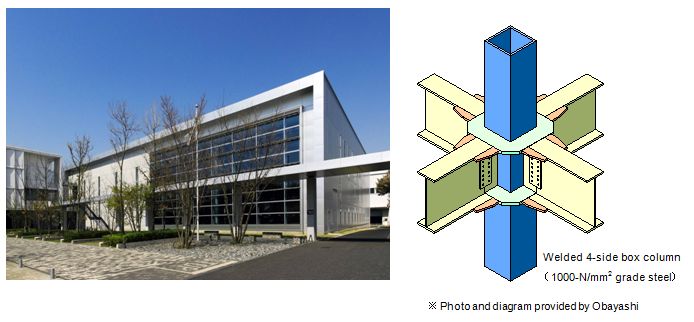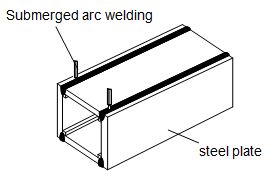World’s Strongest Ultra High Strength 1,000-N Grade Steel for Building Structures Adopted at Obayashi Corporation’s Technical Research Institute
Sep. 11, 2014
Nippon Steel & Sumitomo Metal Corporation
World’s Strongest Ultra High Strength 1,000-N Grade Steel for Building Structures
Adopted
at Obayashi Corporation’s Technical Research Institute
Nippon Steel & Sumitomo Metal Corporation (NSSMC; Representative Director and President - Mr. Kosei Shindo)’s ultra high strength 1,000-N grade steel for building structures (Product Name: BT-HT880) has been adopted at the “Open Labo-2 (*1)”experimental facility at the Technical Research Institute of Obayashi Corporation (Obayashi; Representative Director and President – Mr. Toru Shiraishi).
1,000-N grade steel is the world’s strongest ultra high strength steel for building structures that was developed to improve the earthquake resistance of buildings and has approximately 2.7 times the yield strength (*2) of conventional 490-N grade steel. Amid requirements for larger-scale and taller buildings, the use of 1,000-N grade steel is expected to reduce the quantity of steel used and transportation costs thanks to thinner and lighter steel materials while also shortening processing time at plants and work periods for on-site construction due to a reduction in welding locations and welding volume. It will also be possible to reduce the number of columns in building structures and make them thinner, which will result in large span spaces that combine good design and amenity. Furthermore, owing to the ability to develop structures in which seismic energy dissipation mechanisms absorb the majority of energy while 1,000-N grade steel columns shake elastically, due to combination with energy dissipation mechanisms such as dampers, high earthquake resistance required in business continuity plans (BCPs) will be realized.
On this occasion, NSSMC’s 1,000-N grade steel was used for the column material of “Open Labo-2”, which Obayashi, a leader in Japan’s construction industry, constructed by concentrating leading-edge technologies, and a construction method employing welded 4-sided box column (*3), which is generally used for high-rise buildings as the columns, was adopted to make maximum use of the strength of 1,000-N grade steel. This is the second case where 1,000-N grade steel has been adopted since the No. 1 Building of NSSMC’s Amagasaki R&D Center, which was completed in 2011. NSSMC will continue to contribute to building national resilience as well, including the development of social infrastructure, through the application to structures of ultra high strength steel for building structures.
NSSMC plans to announce this development at the Fiscal 2014 Annual Convention of the Architectural Institute of Japan, which will be held from September 12 (Friday) to 14 (Sunday) (venue: Kobe University).
*1 “Open Labo-2”
An experimental facility at the Technical Research Institute (Kiyose, Tokyo) of Obayashi Corporation. Two-stories above ground, total floor space of 5,210.56m2. Completed in May 2014.

*2 Yield strength
In general, when force is applied to steel material, it changes shape, and when the force is no longer applied, it returns to its original shape. However, if the force applied exceeds a certain strength, the steel does not return to its original shape. This transformation that does not return to the original shape is called plastic deformation. The strength of force up to the limit where plastic deformation occurs is called yield strength. The higher this value, the harder it becomes for fracture or deformation to occur, even if great force is applied. BT-HT880 ultra high strength steel for building structures (yield strength of 880N/mm2)is stronger than the steel plate used in the Tokyo Sky Tree (yield strength of 700N/mm2).
*3:4-sided box column
High-rise buildings use many 4-sided box columns. In the case of 4-sided box columns, steel plates are used for the skin plates, and the columns are usually assembled by using submerged arc welding to weld the skin plates together. As it is possible to reduce the thickness of the steel plate used as skin plates by using 1,000-N grade steel, the weight of the column is lightened and the process time related to welding is reduced.

Nippon Steel & Sumitomo Metal Corporation
Public Relations Center, General Administration Division
TEL: +81-3-6867-2977, 5807
Plate Technology Division, Plate Products Technical Service & Solution Department
TEL: +81-3-6867-6401
Construction Products Development Technology Division, Building Products Engineering Department
TEL: +81-3-6867-6385


